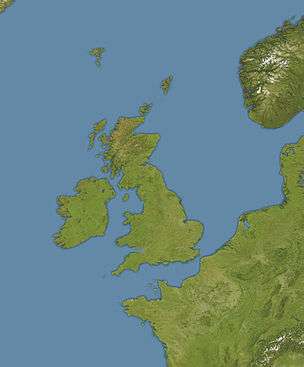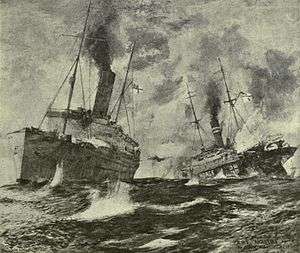RMS Alcantara (1913)
SS Alcantara was an ocean liner that went into service just weeks before the start of World War I, was converted to an armed merchant cruiser in 1915, and was sunk in combat with the German armed merchant cruiser SMS Greif in 1916.
.jpg) RMS Alcantara | |
| History | |
|---|---|
| Name: |
|
| Owner: |
|
| Operator: |
|
| Port of registry: |
|
| Route: | Southampton – Rio de Janeiro – Montevideo – Buenos Aires |
| Builder: | Harland and Wolff, Govan |
| Yard number: | 435G |
| Launched: | 30 October 1913 |
| Completed: | 28 May 1914 |
| Commissioned: | 16 April 1915 |
| Maiden voyage: | 19 June 1914 |
| Fate: | sunk 29 February 1916 |
| General characteristics | |
| Class and type: | A-series |
| Type: |
|
| Tonnage: | 15,831 GRT |
| Length: | 570 feet (170 m) |
| Beam: | 67.2 feet (20.5 m) |
| Propulsion: | 2 × triple-expansion engines, 1 × low-pressure steam turbine, 3 × screws |
| Speed: | 18 knots (33 km/h)[1] |
| Armament: |
|
| Notes: |
|
Ocean liner
Harland and Wolff in Govan[2] built Alcantara for the Royal Mail Steam Packet Company. She was one of the later members of RMSP's "A-series" of liners, which had begun with RMS Aragon launched in 1905. In common with all of the last four "A-series" ships, Alcantara had three screws. A pair of four-cylinder triple-expansion steam engines drove her port and starboard screws, and a Parsons low-pressure steam turbine drove her middle screw.[3]
Alcantara was launched on 30 October 1913 and made her maiden voyage in June 1914 on RMSP's route from Southampton to Rio de Janeiro, Montevideo and Buenos Aires.[2]
Technically any ship while carrying Royal Mail could use the prefix RMS (Royal Mail Ship); in practice this prefix, rather than SS or MS, was always used for RMSP (and later RML) vessels.
HMS Alcantara
In April 1915 the Admiralty requisitioned Alcantara and her "A-series" sisters Avon, Arlanza and Andes to be armed merchant cruisers.[4] She was armed with six 6 in (150 mm) guns,[1] anti-aircraft guns and depth charges. On 17 April at Liverpool she was commissioned into the Royal Navy's 10th Cruiser Squadron as HMS Alcantara.[5] Arlanza and Andes were also commissioned into the 10th Cruiser Squadron, which joined the Northern Patrol that was part of the First World War Allied naval blockade of the Central Powers. The Squadron patrolled about 200,000 square miles (520,000 km2) of the North Sea, Norwegian Sea and Arctic Ocean to prevent German access to or from the North Atlantic.[4]
German submarine attacks on ships voyaging to and from Archangelsk created a suspicion that the Imperial German Navy had established a submarine base somewhere in the Arctic. In the summer of 1915 Alcantara was sent to Jan Mayen Island to investigate. She arrived on 3 July and sent a landing party ashore.[5] It found no evidence of enemy activity; only the remains of the Austro-Hungarian North Pole Expedition base built in 1882 and three Arctic fox cubs, which for a short time were taken aboard as pets.[4]
Battle with Greif

In January 1916 Alcantara embarked on the 10th Cruiser Squadron's G patrol.[6] She was due to return to port on 1 March, but on the morning of 29 February 1916 she was north-east of Shetland en route to a rendezvous with Andes she intercepted the German merchant raider Greif disguised as the Norwegian merchant ship Rena out of Tønsberg, Norway.[1] At 0915 hrs at a range of 6,000 yards Alcantara ordered Greif to stop for inspection, which she did. Alcantara's company went to Action Stations, she trained her guns on Greif,[7] closed to 2,000 yards and slowed to lower a cutter to put an armed guard aboard the suspect ship.[1]
At 0940 hrs Greif increased speed and opened fire.[7] One source claims she raised the Imperial German war ensign ("Kriegsflagge").[1] However, Alcantara's captain, Thomas Wardle, reported that after lowering the Norwegian ensign Greif fought under no flag. The first shell hit Alcantara's bridge, disabling her steering gear, engine order telegraph and all telephones and killing or wounding a number of men. Captain Wardle ordered full speed and open fire at a range of 2,000 yards. A messenger was sent aft and got her after emergency steering gear connected.[7]
Greif turned to starboard[7] and closed range to 750 yards.[6] Several German shells hit Alcantara near her waterline, entering her stokehold bunkers and engine room.[7] Greif tried to torpedo Alcantara. Captain Wardle reported that evasive action at 1002 hrs allowed the torpedo to pass clear under Alcantara's stern, but another source states that a torpedo detonated amidships against Alcantara's port side. A shell from Alcantara's port after 6-inch (150 mm) gun hit and detonated the ready ammunition for Greif's after gun, putting it out of action.[7] By 1015 hrs Greif was badly afire by her bridge and seemed to have stopped. At 1022 hrs Alcantara saw boats leaving Greif and duly ceased fire.[7]

Greif then fired one more shot, and Alcantara duly returned fire. The one shot was later attributed to a shell left in the breech of an abandoned gun being fired by the heat of the fire now raging aboard Greif.[7]
By 1035 hrs Alcantara was reduced to about 3 knots (5.6 km/h)[7] and her after steering gear was disabled.[8] Her helm seemed to be jammed hard over to starboard but she was turning to starboard. Wardle ordered his company to cease fire, stop engines and go to boat stations. The order to stop engines was not received, but flooding in the engine room stopped them. Several of Alcantara's lifeboat falls had been damaged by enemy fire, so that attempts to launch some boats caused men to be dropped into the sea.[7] Alcantara rolled, capsized and sank[8] at 1102 hrs. At least 15 of her boats and a large liferaft floated clear.[7]
The C-class light cruiser HMS Comus and M-class destroyer HMS Munster then arrived. Comus proceeded to rendezvous with Andes about 8,000 yards away, while Munster started rescuing survivors.[7] Greif was carrying a large amount of cork that at first kept her afloat.[8] Andes and Comus reopened fire on Greif.[7] Eventually a large explosion, possibly of ammunition, sank the German ship.[8]
The battle killed 230 men from Greif and 68 from Alcantara.[8] 210 German survivors were rescued.[9]
Notes
- Poole 1975, pp. 52–57.
- Cameron, Stuart; Strathdee, Paul; Biddulph, Bruce; Robinson, George. "ss Alcantara". Clyde-built Ship Database. Archived from the original on 7 January 2016. Retrieved 27 January 2015.CS1 maint: unfit url (link)
- Nicol 2001, p. 101.
- Nicol 2001, p. 113.
- Smith, Kay (ed.). "HMS Alcantara – April 1915 to January 1916, Northern Patrol (10th Cruiser Squadron)". Royal Navy Log Books of the World War 1 Era. naval-history.net. Retrieved 27 January 2015.
- Nicol 2001, p. 114.
- Wardle, Thomas. "Report by Captain Wardle, HMS Alcantara". Letters. Mackenzie J Gregory. Retrieved 27 January 2015.
- Nicol 2001, p. 115.
- Schmalenbach 1977, p. 24.
Sources
- Osborne, Richard; Spong, Harry; Grover, Tom (2007). Armed Merchant Cruisers 1878–1945. Windsor, UK: World Warship Society. ISBN 978-0-9543310-8-5.
- Nicol, Stuart (2001). MacQueen's Legacy; Ships of the Royal Mail Line. Two. Brimscombe Port and Charleston, SC: Tempus Publishing. pp. 101, 113–115. ISBN 0-7524-2119-0.CS1 maint: ref=harv (link)
- Poole, Francis (July 1975). "Alcantara vs. Greif: Duel of the Merchant Cruisers". Proceedings. Annapolis, MD: United States Naval Institute: 52–57.CS1 maint: ref=harv (link)
- Schmalenbach, Paul (1977). German Raiders. Annapolis, MD: Naval Institute Press. ISBN 0-85059-351-4.CS1 maint: ref=harv (link)
External links
- Gregory, Mackenzie J. "Greif". Marauders of the Sea, German Armed Merchant Raiders During World War I. Retrieved 27 January 2015.